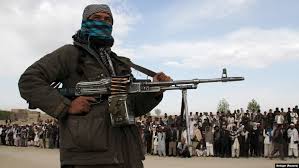KABUL: Four men were put to death in public executions in Afghanistan on Friday, marking the highest number carried out in a single day since the Taliban returned to power in 2021. According to the Supreme Court, these executions took place in sports stadiums across three provinces.
With these latest events, the total number of public executions in Afghanistan since the Taliban’s return has now reached 10. Such executions were common during the group’s first rule between 1996 and 2001, often taking place in stadiums before large crowds.
Two of the men were executed in Qala-i-Naw, the capital of Badghis province. Witnesses told AFP that they were shot multiple times—around six or seven times each—by a male relative of the murder victims.
“They were made to sit and turn their backs to us. A family member stood behind and shot them,” said Mohammad Iqbal Rahimyar, a 48-year-old who watched the execution unfold.
The Supreme Court said the men had been sentenced to “retaliatory punishment” for killing others. It claimed that the trials were “thorough and repeated.” The victim’s families were given a choice to forgive the killers. They refused.
A man outside the stadium, who gave his name as Zabihullah, supported the decision. “If they had been forgiven, it would’ve been better. But this is God’s command. It must be done,” he said.
The local authorities had sent out notices a day earlier, inviting residents to attend the executions. A third man was executed in Zaranj, the capital of Nimroz province. The fourth was killed in Farah city in western Afghanistan, the court confirmed.
“It’s good that the Islamic Emirate shows its strength. I’m happy about that,” said Javid, a 30-year-old spectator, referring to the Taliban’s official title.
International human rights group Amnesty International condemned the public executions in Afghanistan. They called the practice a “gross affront to human dignity.”
The last known execution before this took place in November 2024. A convicted murderer was shot three times in the chest by a family member of the victim. That execution was also held in a stadium—this time in Gardez, the capital of Paktia province. Thousands, including Taliban officials, were present.
Since regaining control, the Taliban have frequently used corporal punishment. Flogging is regularly applied for crimes like theft, adultery, and drinking alcohol. But only the group’s Supreme Leader, Hibatullah Akhundzada, has the power to approve executions. He resides in Kandahar, the Taliban’s stronghold.
In 2022, Akhundzada ordered full implementation of Islamic law as interpreted by the Taliban. This includes qisas, or “eye-for-an-eye” justice. That form of retribution permits the death penalty when someone is convicted of murder.
Maintaining strict law and order is a core principle of the Taliban’s hardline rule. The movement rose out of the post-Soviet civil war chaos in the 1990s. Their brutal justice system gained global attention during that era.
One of the most haunting images from the Taliban’s first rule showed the 1999 execution of a woman in a burqa at a Kabul stadium. She had been accused of killing her husband.
The United Nations and various rights groups continue to criticize the Taliban’s use of both corporal punishment and the death penalty. Amnesty International said Afghanistan still hands out death sentences after trials that fail to meet international standards.
In its April report, Amnesty noted that 1,518 executions took place globally in 2024. That number did not include thousands believed to have occurred in China, which remains the world’s top enforcer of capital punishment.
The return of public executions in Afghanistan has sparked global concern. But inside the country, many still view them as justice being served. The Taliban leadership continues to push forward with their strict interpretation of Islamic law, regardless of international pressure.


